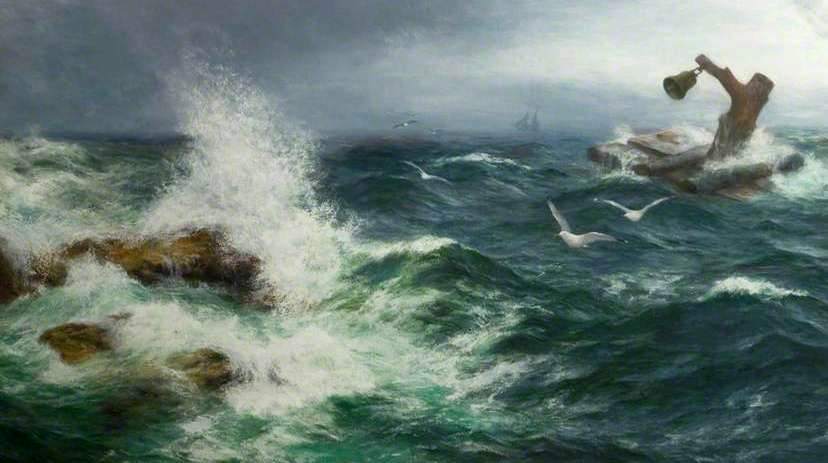Thomas Hood (23 May 1799 – 3 May 1845) was born in London. He became a humourist and a poet. His most famous poem The Song of the Shirt was published in The Punch in 1843 which made him an overnight sensation. The series of the Comic Annual, dating from 1830, was a kind of publication popular at that time, which Hood undertook and continued almost unassisted for several years. Under that title he treated all the leading events of the day in caricature, without personal malice, and with an undercurrent of sympathy. Readers were also treated to an incessant use of puns, of which Hood had written in his own vindication, “However critics may take offence,/A double meaning has double sense”, but as he gained experience as a writer, his diction became simpler.
About the poem –
The poem is one of the most reflective and sentimental of Thomas’s poems and shows a rare depth of sentiments which are not uncontrolled yet touching similar chords in our lives and hearts. It was published in 1826 in Friendship’s Offering.
The poet reminisces about his joys of childhood often comparing them with his present state of adult pensiveness. He remembers every ounce of joy that he received beginning from his childhood’s morning where the sun and other natural objects were kind to him. He then remembers the flowers that made him happy. He talks about his childhood playthings including the swing and the fun it brought him. Ultimately he rues the passage of time where he was the most close to heaven though he was unconscious of the same. He years to go back to the blessed time and stay there unchanged forever.
The single running theme of the poem seems to be the contrast of the joy filled days of the past and the present days of pain and sorrow. The poem is more of a description of all the things that the poet misses as a grown up when he has become over burdened with tensions of an adult life.
The poem truly belonging to the tradition of the romantic poetry is overtly simple with almost a nursery rhyme pattern, complete with a refrain – ‘I remember, I remember’. Though the tone is predominantly melancholic it’s not depressing. The poem invokes little memories of things for the poet and the readers to rejoice just like summer showers reduce the unbearable heat of the summer in tropical countries like ours. The poem being divided into four stanzas perhaps metaphorise the breakup of a day into four divisions. The first sees the poet getting up from the bed called up by the sun. Curiously the sun has been personified into a person who is never late either to come or go. Unlike a boy who hating to go to school does not wake up early or at least do not want to, the poet in his childhood is glad to wake up on a sunny day and enjoy himself. One of the main pillars of romanticism has been invoked here which involves the glorification of childhood. Here the boyhood of the poet is glorified. The many naughtiness of the poet has been brushed aside to highlight the immutable innocence and glory of the child. This eulogy to childhood is augmented by the tendency to lose present worries in the reminiscence of the glorious days of past. No wonder the poem falls under the category of escapist poetry. However, the poet Keats like is well aware that what he is doing is not real but remembers as to what has been. The vivid description of the flowers is a superb symbol of romantic love of nature which continues with the evocation of a tree that still stands today. This tree could both be the symbol of yet untouched memories of childhood or it could be ironically a marker of the contrastive position that the poet today is as opposed to his youthful and carefree days. The country pleasures for the boy are also remembered which evokes yet another meme from the romantic treasure chest that is of glorification of the country life as opposed to the present cumbersome days of the city life. Even the ignorance of the child about his distance from heaven is counted as a bliss which reminds us of Wordsworth’s –
“It was bliss to be alive at that dawn
But to be young was very heaven.”
Now the poet has realized that the fir trees whose high branches were thought by the poet to be a place closer to heaven were actually not so close to heaven, he rues the lack of this innocence. So this poem could also be dubbed as a poem of growing up where the essential bond between a child and his surroundings are broken with the dawn of intelligence and knowledge.
The stanzas are filled with such images which will make the pictures with a camera run for their money. The ekphrasian quality of the poet is at its maximum in such images as – “The little window”, “Those flowers made of light”, “Where I was used to swing”, “The fir trees dark and high”. The entire seems to be a series of images which follow one another as a series of natural occurrences filling our minds and hearts with what Arnold says are the chief qualities of literature – “sweetness and light”. These images have a cinematic quality in their economy and ability to impact the mind’s eye.
Thus we can say that the poem is one those poems written by Thomas Hood which would make us remember him again and again when we are going to remember the days past in sighs and tears.
Dear Readers- If this summary/analysis has helped you, kindly take a little effort to like or +1 this post or both. Make sure you like Beamingnotes Facebook page and subscribe to our newsletter so that we can keep in touch. We’ll keep informing you about stuffs that are really interesting, worth knowing and adds importance to you.
Some online learning platforms provide certifications, while others are designed to simply grow your skills in your personal and professional life. Including Masterclass and Coursera, here are our recommendations for the best online learning platforms you can sign up for today.
The 7 Best Online Learning Platforms of 2022
- Best Overall: Coursera
- Best for Niche Topics: Udemy
- Best for Creative Fields: Skillshare
- Best for Celebrity Lessons: MasterClass
- Best for STEM: EdX
- Best for Career Building: Udacity
- Best for Data Learning: Pluralsight

















Thanks so much for the clear and vivid review..
pls the pronoun He in line 5 refers to what??? thanks alot
he here refers to the sun.
Very useful and lovely analysis. I enjoyed it and it enhanced my passioate love of getting and enjoying poems and prose.
Do u have analysis of Hemingway’s The old man and the see”. I like to read your analysis also of Shakespeare As I like it. Thanks a lot.
Great Great GReat…thats all I can say for now
Loved it?☺
Very nicely described.
it helped me a lot thanks a lot 🙂
It helped me to write the analysis and summary properly
it is very helpful thank you very much
Great
Your analysis is simple, without being simplistic, prescient and free flowing. Thanks a lot.
i am too a school teacher. Many a times, before explaining, i have used your analysis to explain my students well. Thank you again.
best summary website for me till date…………….thanks a lot
What does it mean when it says “To swallows on the wing”?